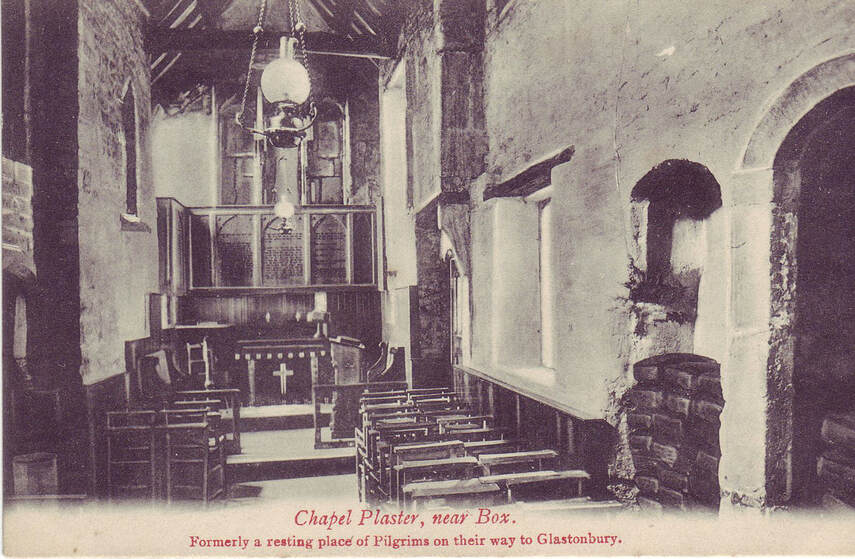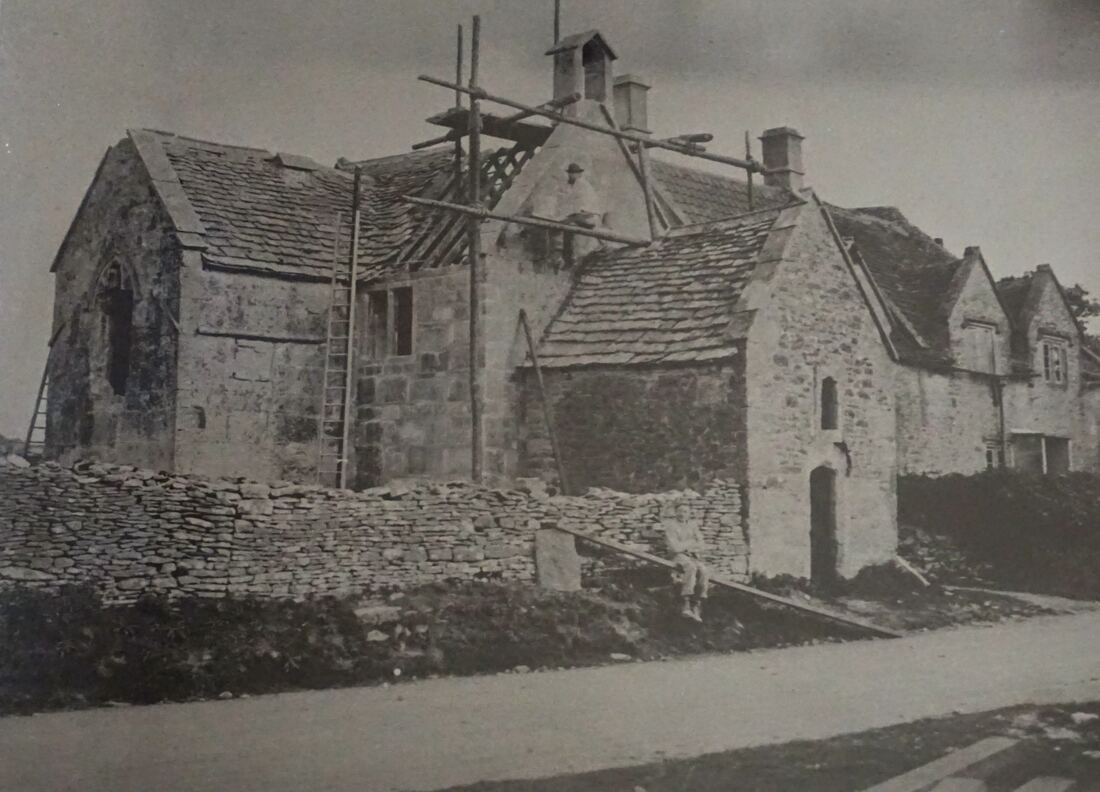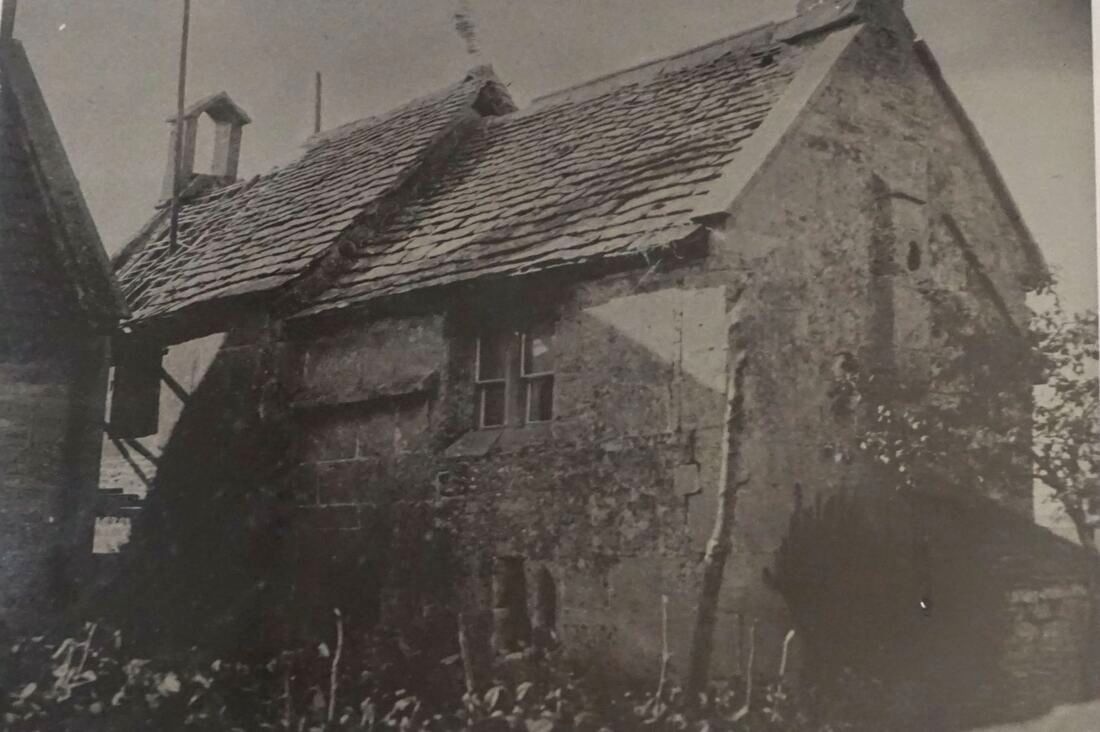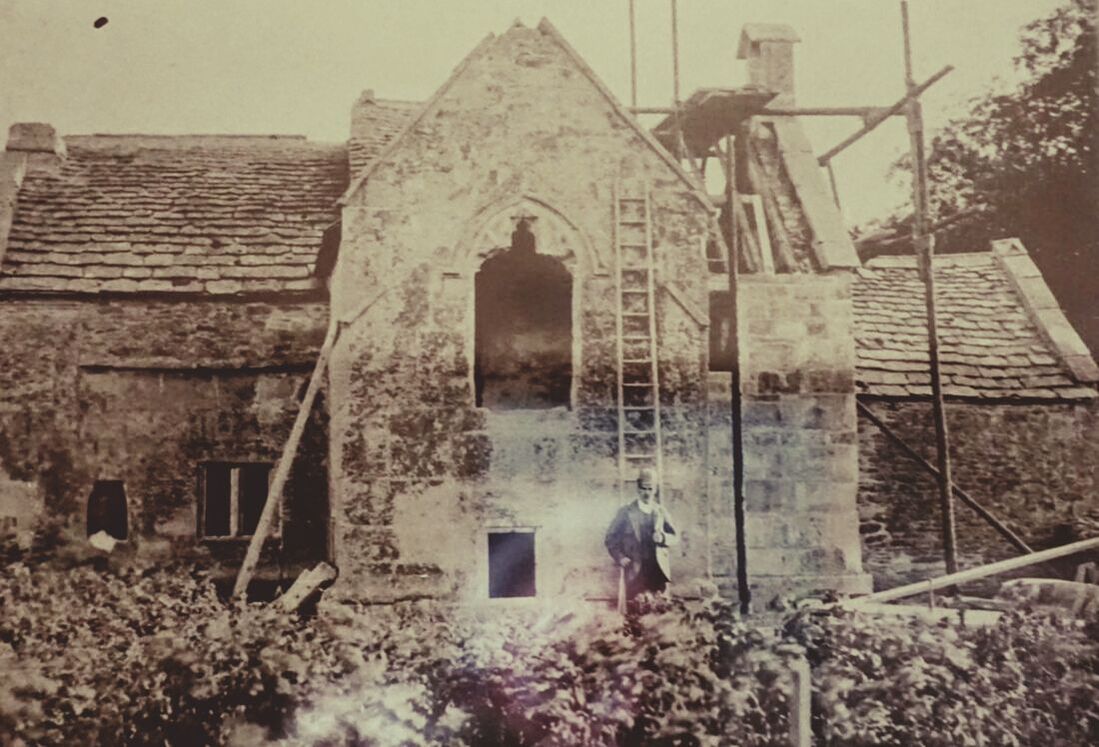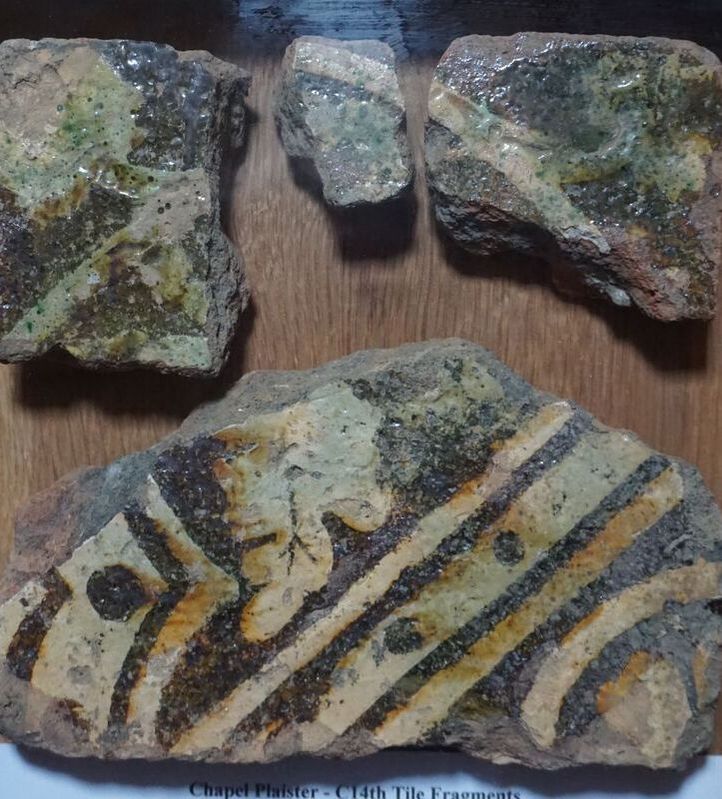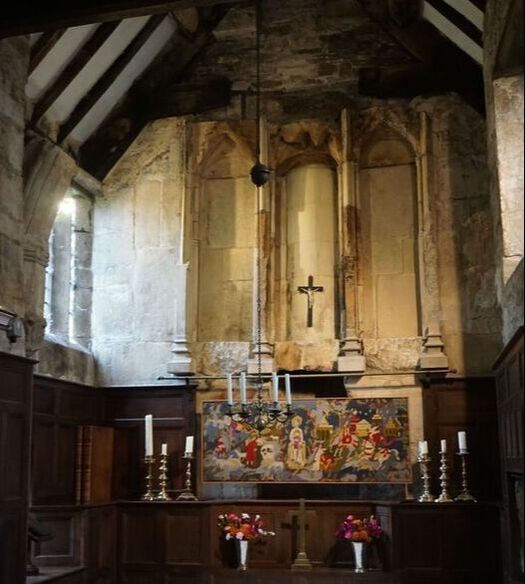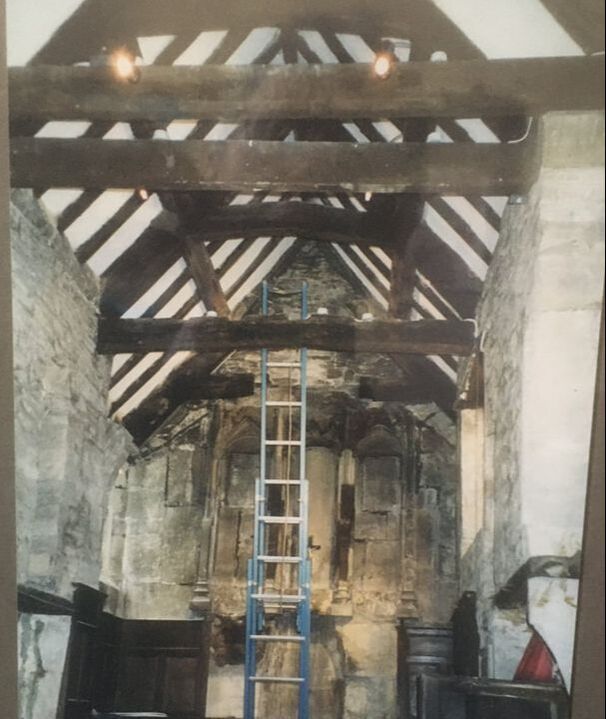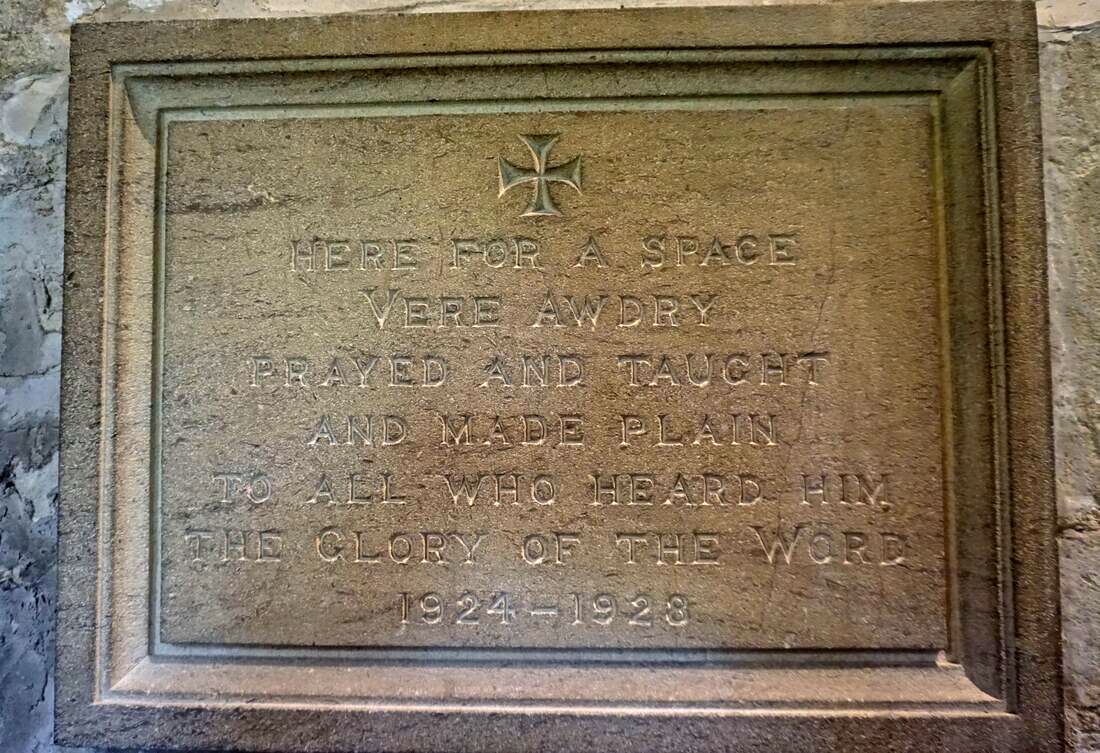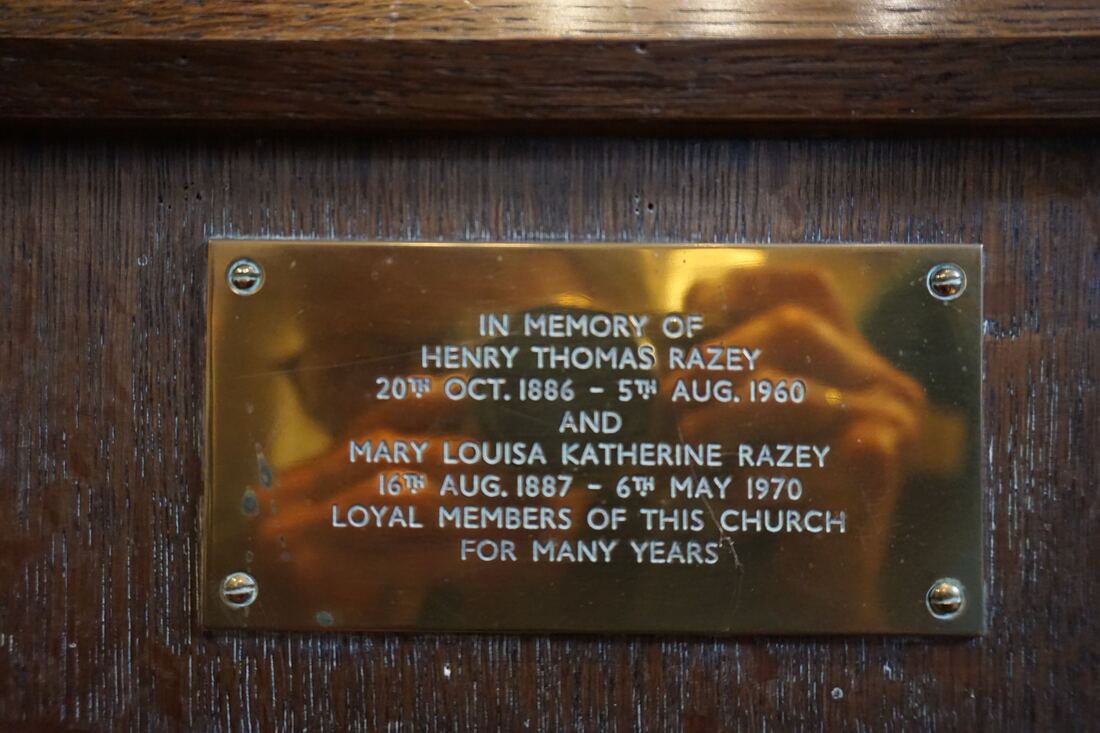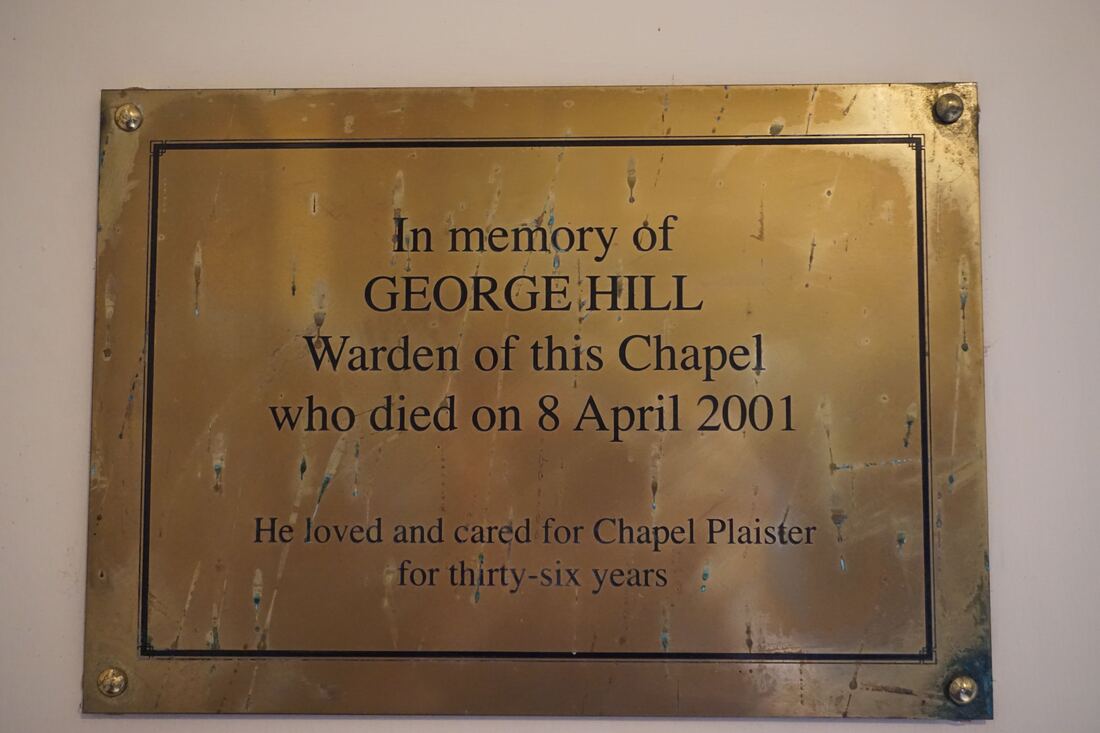Chapel Plaister Alan Payne December 2022
There are few buildings in Box which have changed as much as Chapel Plaister whilst retaining vestiges of its history. In turn, the building has been a chapel, domestic residence, storeroom and back to a chapel again. Its restoration has been due to the dedication of a few distinguished patrons as the congregation is limited to a handful of people by its small size. Notwithstanding these difficulties, it is one of the most loved properties in Box.
Medieval History
The outline history of Chapel Plaister is well-known, although authoritative information is patchy. It has never been a church because it lacks a consecrated burial ground but was a medieval chapel-of-ease, a religious building convenient for worship by the local population.
In 1340, the rector of Hazelbury Church, William of Rysindon, was granted a licence to preach by the bishop of Sarum (Salisbury) in the chapel of Pleistede in the parish of Hazelbury. The Church of Hazelbury had previously been granted to the Augustinian Priory of Bradenstoke, Lyneham, in about 1220 and it has been suggested that the priory may have built the chapel. This seems likely as, although the monastic order was famous for its learning, it had mendicant order of missionary friars (vagabonds who lived by begging). The manor of Parva Rysindon was possibly the village of Little Swindon, Gloucestershire, where William of Rysindon may have been a parish priest in 1282.[1] In 1346 the Hazelbury rector was instructed to pay to the new prior three shillings a year in respect of his dues.[2] An amazing account of a pilgrimage just a year after 1348 has emerged, recorded in our article about the Black Death. Notwithstanding these details, it is likely that the usage of the building fundamentally changed after the ravages of the Black Death in 1348.
The building was in regular use in the 1400s and the porch on the front is believed to be an addition dating from then. The architecture of the building suggests it was a one-storey construction, with a cell on the north side (possibly for monk or priest) which was later widened and incorporated into the structure. In about 1536, John Leyland visited the chapel, calling it a hermitage without any evidence but indicating its religious usage. Some years after the Reformation and the English Civil war in about 1680, John Aubrey, a local man from Kington Langley, Chippenham, claimed that the chapel was a known place on the Roade (London to Bath). It was heretofore a place of entertainment for Pilgrims that went to Glastonbury, to St Joseph of Arimathea’s Chapell. It is now an ale-house.
The building was converted in the early 1700s into two residences (east and west) each two storeys with a straight exterior staircase added for access to the front cottage. In the 1750s, the area of Chapel Plaister was the haunt of a highwayman John Poulter, who frequented the ale-house The Bell Inn, next door. Poulter was hanged in 1753. At some point afterwards, Chapel Plaister ceased to be dwellings and became a bakery and later a store for farm implements.
The outline history of Chapel Plaister is well-known, although authoritative information is patchy. It has never been a church because it lacks a consecrated burial ground but was a medieval chapel-of-ease, a religious building convenient for worship by the local population.
In 1340, the rector of Hazelbury Church, William of Rysindon, was granted a licence to preach by the bishop of Sarum (Salisbury) in the chapel of Pleistede in the parish of Hazelbury. The Church of Hazelbury had previously been granted to the Augustinian Priory of Bradenstoke, Lyneham, in about 1220 and it has been suggested that the priory may have built the chapel. This seems likely as, although the monastic order was famous for its learning, it had mendicant order of missionary friars (vagabonds who lived by begging). The manor of Parva Rysindon was possibly the village of Little Swindon, Gloucestershire, where William of Rysindon may have been a parish priest in 1282.[1] In 1346 the Hazelbury rector was instructed to pay to the new prior three shillings a year in respect of his dues.[2] An amazing account of a pilgrimage just a year after 1348 has emerged, recorded in our article about the Black Death. Notwithstanding these details, it is likely that the usage of the building fundamentally changed after the ravages of the Black Death in 1348.
The building was in regular use in the 1400s and the porch on the front is believed to be an addition dating from then. The architecture of the building suggests it was a one-storey construction, with a cell on the north side (possibly for monk or priest) which was later widened and incorporated into the structure. In about 1536, John Leyland visited the chapel, calling it a hermitage without any evidence but indicating its religious usage. Some years after the Reformation and the English Civil war in about 1680, John Aubrey, a local man from Kington Langley, Chippenham, claimed that the chapel was a known place on the Roade (London to Bath). It was heretofore a place of entertainment for Pilgrims that went to Glastonbury, to St Joseph of Arimathea’s Chapell. It is now an ale-house.
The building was converted in the early 1700s into two residences (east and west) each two storeys with a straight exterior staircase added for access to the front cottage. In the 1750s, the area of Chapel Plaister was the haunt of a highwayman John Poulter, who frequented the ale-house The Bell Inn, next door. Poulter was hanged in 1753. At some point afterwards, Chapel Plaister ceased to be dwellings and became a bakery and later a store for farm implements.
Restoration 1893
It is often asserted that the Rev Shirley Alan Spooner, curate at Box Church, took it upon himself to renovated Chapel Plaister in 1893. The truth is slightly different. Dr Spooner lived at Myrtle Cottage, Box High Street for only a few years, probably from 1893 to 1897. He was recorded as making considerable pastoral efforts in the village at the Flower and Vegetable Show and the Friendly Society Fetes. The reason for his appointment was the incapacity of the vicar Rev George Gardiner following a train accident (until Gardiner’s retirement in 1896). Rev Spooner was accustomed to the difficulties in restoring ecclesiastical buildings, having played a small part in the re-opening of the ancient Edington Church, Westbury, in 1891.[3]
It is often asserted that the Rev Shirley Alan Spooner, curate at Box Church, took it upon himself to renovated Chapel Plaister in 1893. The truth is slightly different. Dr Spooner lived at Myrtle Cottage, Box High Street for only a few years, probably from 1893 to 1897. He was recorded as making considerable pastoral efforts in the village at the Flower and Vegetable Show and the Friendly Society Fetes. The reason for his appointment was the incapacity of the vicar Rev George Gardiner following a train accident (until Gardiner’s retirement in 1896). Rev Spooner was accustomed to the difficulties in restoring ecclesiastical buildings, having played a small part in the re-opening of the ancient Edington Church, Westbury, in 1891.[3]
Above Left: View from the south-east, previously being repaired. The oven at the east end was afterwards removed 25 August 1893; and
Above Right: View from the north showing the transept window before being restored, The north-west quoin of the nave and bell turret gable just rebuilt 25 August 1893. Incidentally, it possibly shows Rev Spooner supervising the work (photos courtesy Chapel Plaister archives)
Above Right: View from the north showing the transept window before being restored, The north-west quoin of the nave and bell turret gable just rebuilt 25 August 1893. Incidentally, it possibly shows Rev Spooner supervising the work (photos courtesy Chapel Plaister archives)
There had been considerable interest in the renovation of the chapel with visits by the Wiltshire Archaeology and Natural History Society in the early 1880s.[4] The notables of the village joined in efforts to fundraise for the cost of the work, including Constance Northey, the eldest daughter of lord of the manor George Wilbraham Northey, and her husband Rev Walter Barlow.[5] In 1895, the distinguished architect Harold Brakspear led celebratory meetings to inspect the work.[6] Brakspear’s work legitimised the history of the building – this interesting little chapel – which he claimed showed evidence of a medieval hospital which was widened in the 1400s, with a first floor accessed by an external twisted staircase. He recorded the blackening behind the altar as caused by a bakery oven and asserted that later uses included as a lumber store. The outcome of his work was the re-dedication of the building for religious purposes. The 1893 restoration altered the building completely. It cut through the beams supporting the first floor, opening the roof timbers in an effort to restore the building for religious services.
Later Restorations
Over the years, neighbours have often taken a lead in maintaining the chapel. Few did more in this respect than George Jardine Kidston, owner of Hazelbury Manor, a retired diplomat and keen amateur historian. He installed an underfloor hot-air system, removing and saving the medieval tiles (shown below left) and oak panelling to keep the building warmer. His work made the chapel a suitable place for contemplation and spiritual renewal, as can be seen in the chancel (below right - both photographs courtesy Carol Payne).
Over the years, neighbours have often taken a lead in maintaining the chapel. Few did more in this respect than George Jardine Kidston, owner of Hazelbury Manor, a retired diplomat and keen amateur historian. He installed an underfloor hot-air system, removing and saving the medieval tiles (shown below left) and oak panelling to keep the building warmer. His work made the chapel a suitable place for contemplation and spiritual renewal, as can be seen in the chancel (below right - both photographs courtesy Carol Payne).
|
The restoration of the entire roof in 1999 involved new oak lathes and replacing the leadwork, removal of the roof plaster and relaying the roof tiles and installing new ones where needed, as well as improving the drainage and rewiring the interior.[8]
It was vital work to stop water ingress causing untold damage to the fabric of the building. Pleasingly, the structural roof timbers were found to be solid, resulting in completion in just six months. Terry Waldron from Westrop, Swindon carried out most of the work. The cost of the project was reported to be £75,000. After grants from English Heritage and other charitable trusts, £14,000 was required to be raised locally, a task largely falling on the shoulders of Chris Ward and Jerry Dix.[9] The completion of the work on 19 June 1999 was commemorated in the presence of Bishop John Neale and the vicar of Box Church John Flory. Right:The ceiing replastered and new lights being installed (photograph on display in the chapel) |
Epitaphs
A number of other people were deeply attached to the little chapel as witnessed by the number of plaques on the walls.
The admirers included Rev Vere Awdry (epitaph below left in the south wall of the chancel) who Prayed and Taught and Made Plain to all who heard him The Glory of the Word 1924-28. A brass plaque exists to Henry Razey (20 October 1886-6 May 1970) and his wife Mary Louisa Katherine Razey (16 August 1887-6 May 1970) on the north wall of the nave (below middle). In the west porch (below right) is a plaque dedicated to George Hill Warden of this chapel. He loved and cared for Chapel Plaister for 36 years.
A number of other people were deeply attached to the little chapel as witnessed by the number of plaques on the walls.
The admirers included Rev Vere Awdry (epitaph below left in the south wall of the chancel) who Prayed and Taught and Made Plain to all who heard him The Glory of the Word 1924-28. A brass plaque exists to Henry Razey (20 October 1886-6 May 1970) and his wife Mary Louisa Katherine Razey (16 August 1887-6 May 1970) on the north wall of the nave (below middle). In the west porch (below right) is a plaque dedicated to George Hill Warden of this chapel. He loved and cared for Chapel Plaister for 36 years.
Also on the walls is a tapestry in memory of Nicholas Barton from Wadswick by Mary Barton, his grandmother, to honour his death in 1997, aged just 21.
Conclusion
These brief details are the history of Chapel Plaister which can be verified. Other items are more speculative including the building of the chapel by Sir John du Plessis in the 1200s, which was challenged by Ken Watts who dated the building as about 1460.[10] Other speculation includes the name being Anglo-Saxon for “play place”, and its purpose as a “pilgrim’s place of entertainment” on route to Glastonbury with a medieval scallop shell outside. Equally questionable (by none other than Sir Harold Brakspear) is that the cavity on the outside of the building was used as a holy water stoup. These stories give colour to the history but they aren’t really needed for what is already a magnificent Grade I listed building.[11]
These brief details are the history of Chapel Plaister which can be verified. Other items are more speculative including the building of the chapel by Sir John du Plessis in the 1200s, which was challenged by Ken Watts who dated the building as about 1460.[10] Other speculation includes the name being Anglo-Saxon for “play place”, and its purpose as a “pilgrim’s place of entertainment” on route to Glastonbury with a medieval scallop shell outside. Equally questionable (by none other than Sir Harold Brakspear) is that the cavity on the outside of the building was used as a holy water stoup. These stories give colour to the history but they aren’t really needed for what is already a magnificent Grade I listed building.[11]
References
[1] See Feet of Fines: CP 25/1/284/22 (medievalgenealogy.org.uk) document CP25/1/284/22 number 120
[2] Reported in Chapel Plaister brochure, p.2
[3] Salisbury and Winchester Journal, 3 October 1891
[4] The Wiltshire Times, 13 August 1881
[5] The Wiltshire Times, 29 December 1894
[6] The Wiltshire Times, 10 August 1895
[7] Parish Magazine, March 1998 and June and September 1999
[8] Parish Magazine, June 1999
[9] Parish Magazine, March 1998 and September 1999
[10] Ken Watts, The Wiltshire Cotswolds, 2007, The Hobnob Press, p.199
[11] Julian Carosi has included a detailed timetable for the chapel in chapter 5 of his 'Corsham Revealed Three' book
[1] See Feet of Fines: CP 25/1/284/22 (medievalgenealogy.org.uk) document CP25/1/284/22 number 120
[2] Reported in Chapel Plaister brochure, p.2
[3] Salisbury and Winchester Journal, 3 October 1891
[4] The Wiltshire Times, 13 August 1881
[5] The Wiltshire Times, 29 December 1894
[6] The Wiltshire Times, 10 August 1895
[7] Parish Magazine, March 1998 and June and September 1999
[8] Parish Magazine, June 1999
[9] Parish Magazine, March 1998 and September 1999
[10] Ken Watts, The Wiltshire Cotswolds, 2007, The Hobnob Press, p.199
[11] Julian Carosi has included a detailed timetable for the chapel in chapter 5 of his 'Corsham Revealed Three' book
